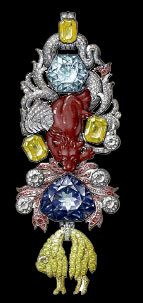Rose de Paris

A gouache designed by Pascal Monney for Herbert Horovitz showing a reconstitution of Louis XV's Great Golden Fleece, designed in 1749.

The big blue heartshaped diamond has a long history. It was brought from India by Jean-Baptiste Tavernier in 1668, and purchased by Louis XIV who had it cut in 1671, in that extraordinary and difficult symmetry based on number 7 with a radiant sun in the middle, called "Rose de Paris". It became the second biggest diamond in the king's collection ; the first one being the Sancy which belongs now in to the Musée du Louvre.
During the French Revolution, in 1792, the jewels of the Crown were stolen. Some of the stolen pieces were found, but the 'rose de Paris' was still missing, until...
In 2007, François Farges from the Museum d'Histoire Naturel de Paris and his team found a lead copy of the "rose de Paris " in the reserve of the museum. For the first time it was possible to know precisely how big the stone was and its precise shape. At seeing it, Farges had the intuition that maybe the "Hope diamond", a smaller blue diamond, belonging to the Smithsonian Institute, and that appeared a few years after the Jewels of the Crown had been stolen, was the "Rose", reworked and made impossible to be recognized and claimed by France.
After some calculations and computer modelizations, which detail was published in the Revue de Gemmologie, François Farges came to the conclusion that the Hope and the "Rose de Paris" are the same stone.

This red stone, a spinel, which belonged to Marguerite de Foix, and then to her daughter, Anne de Bretagne (1477-1514) who became queen of France and brought it to the Crown. Under Louis XV the stone was cut in the shape of a draco and included to the Great Goldren Fleece.
---
Farges F., Sucher S., Horovitz H. and Fourcault J-M., "Deux découvertes majeures autour du 'diamant bleu' de la Couronne, Revue de Gemmologie, volume 165, pp. 17-24, 2008.
 17th & 18th-Century history, arts & music
17th & 18th-Century history, arts & music
0 Comments:
Post a Comment
<< Home